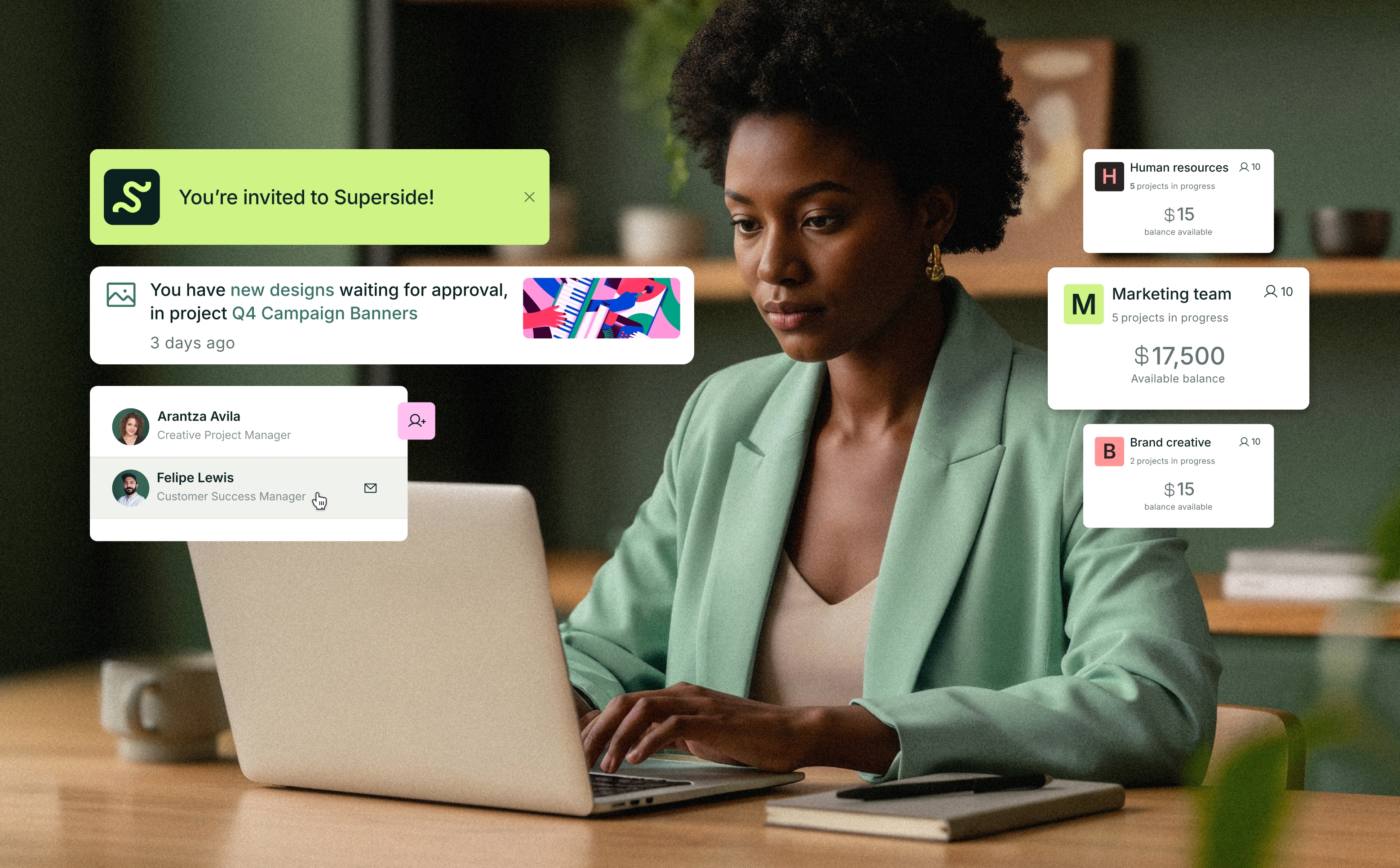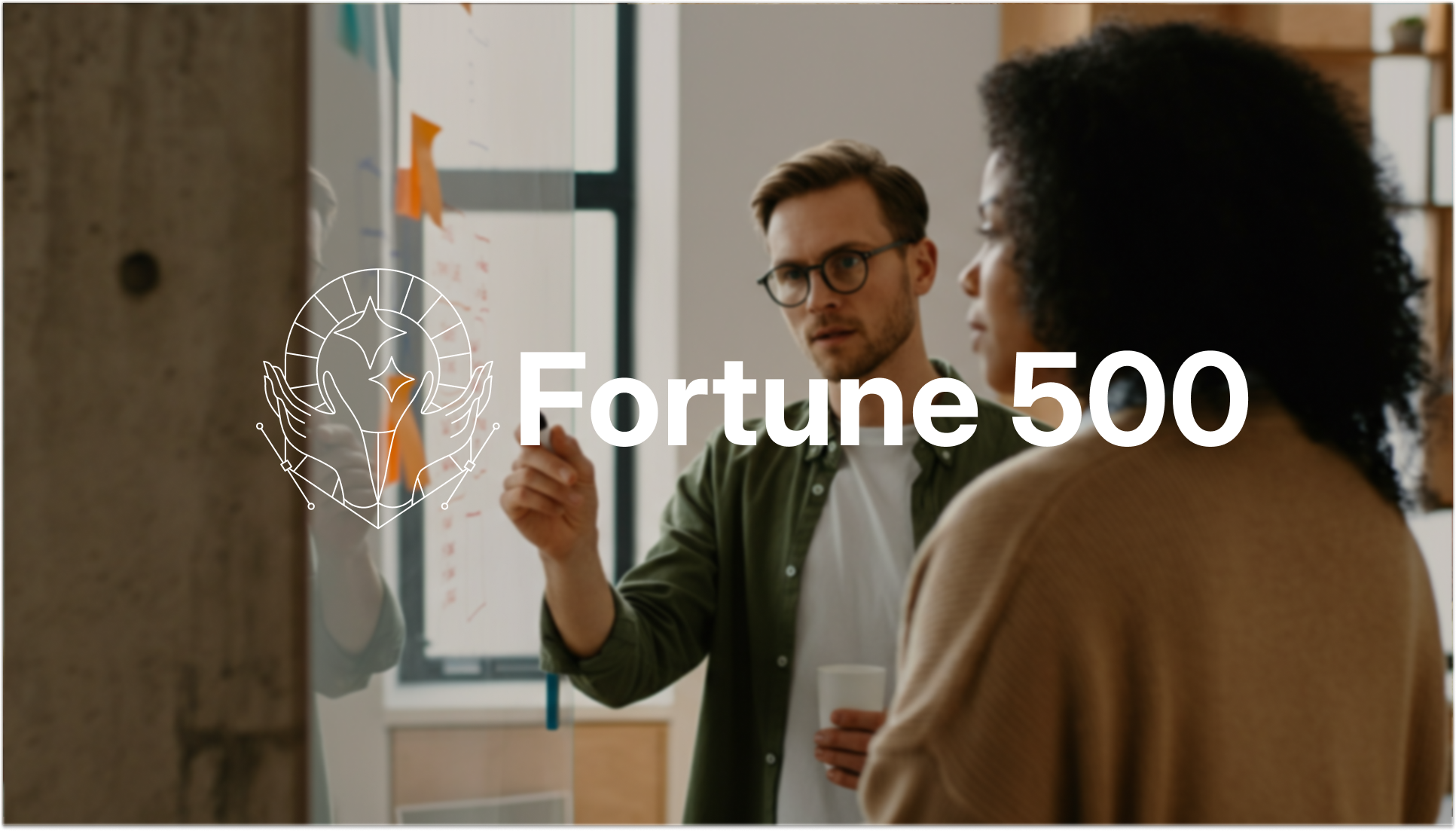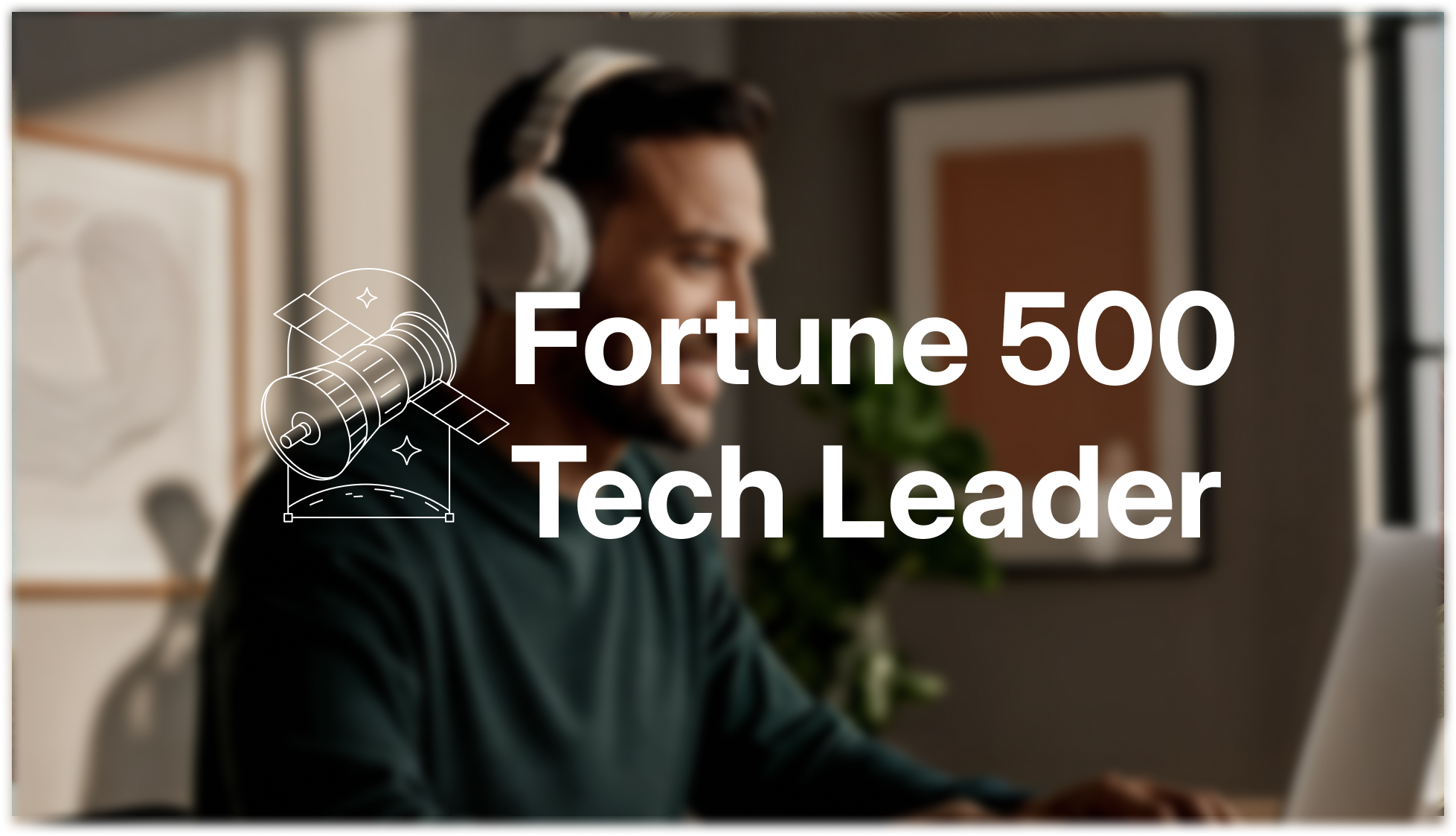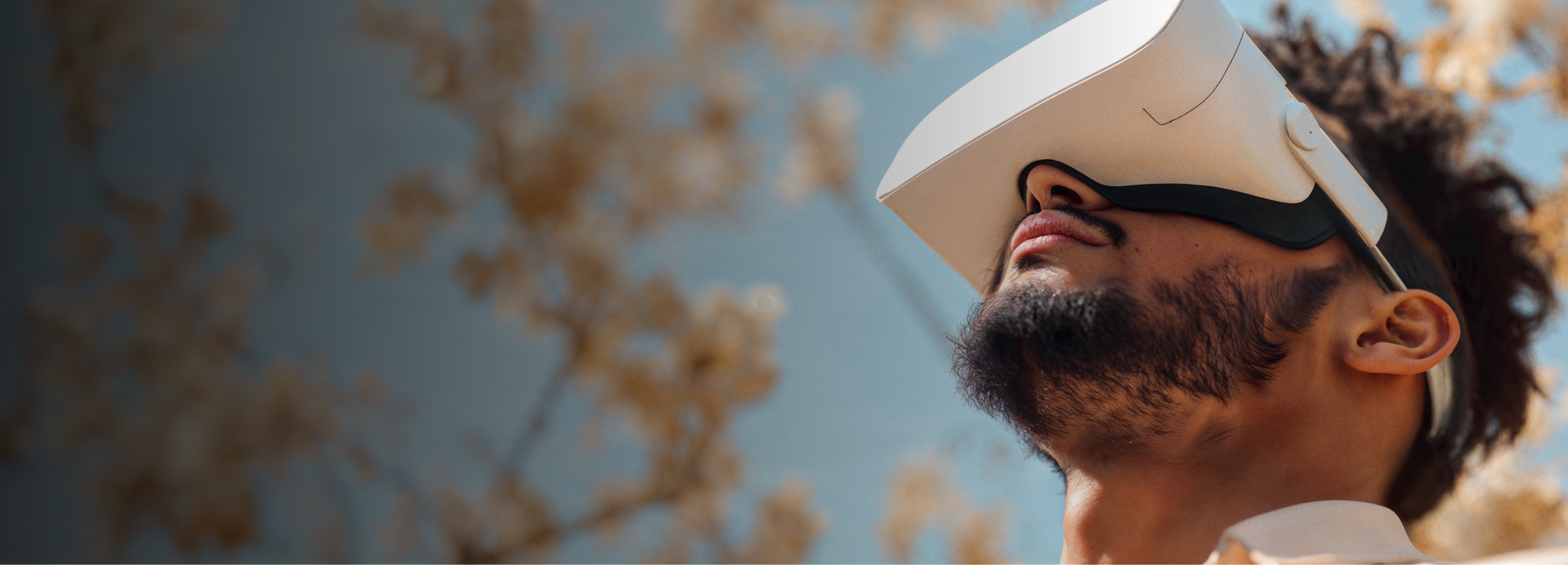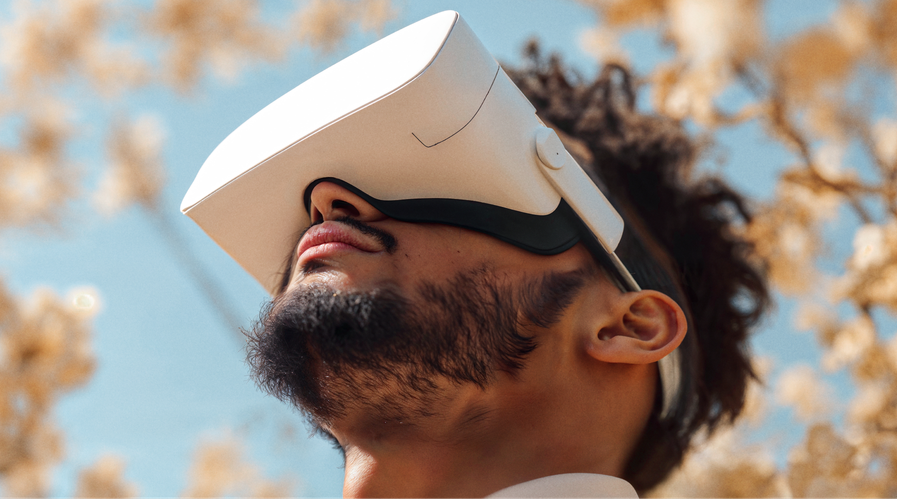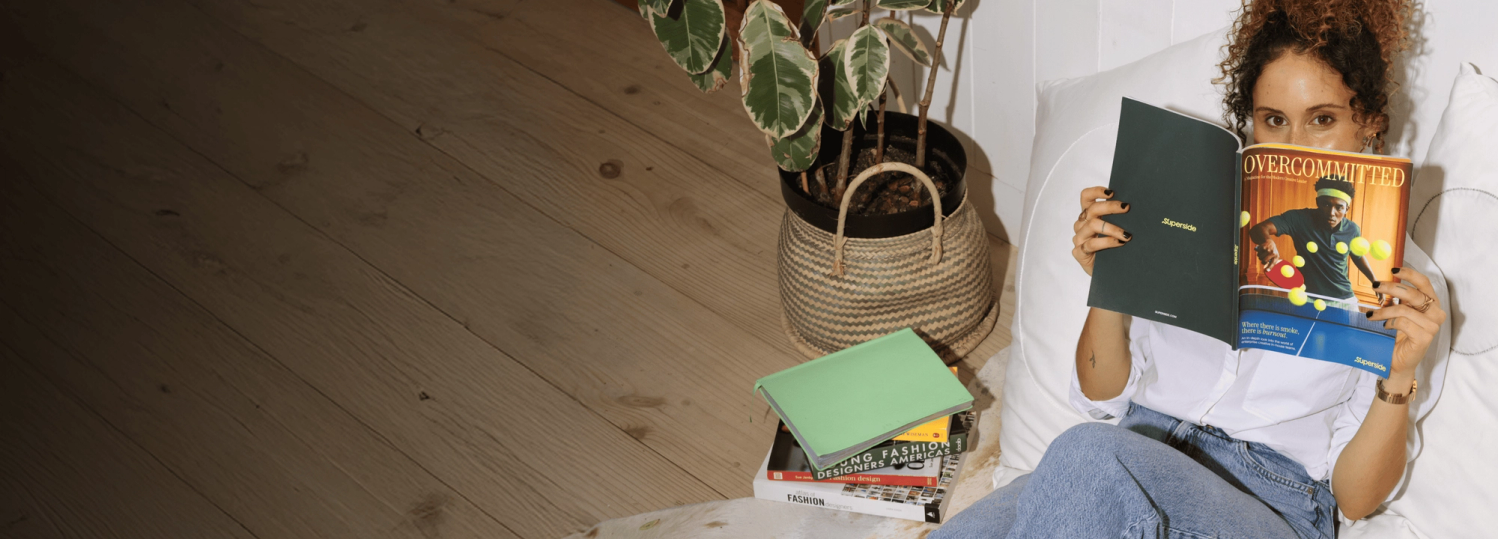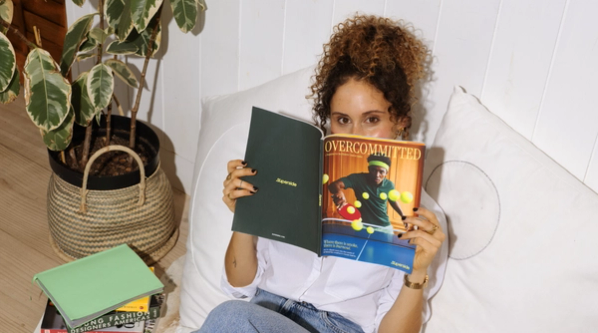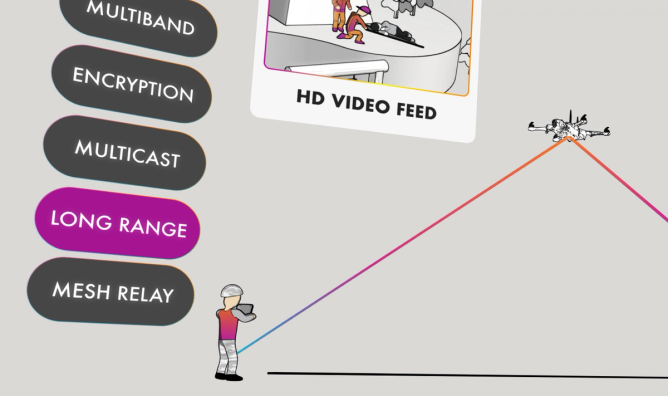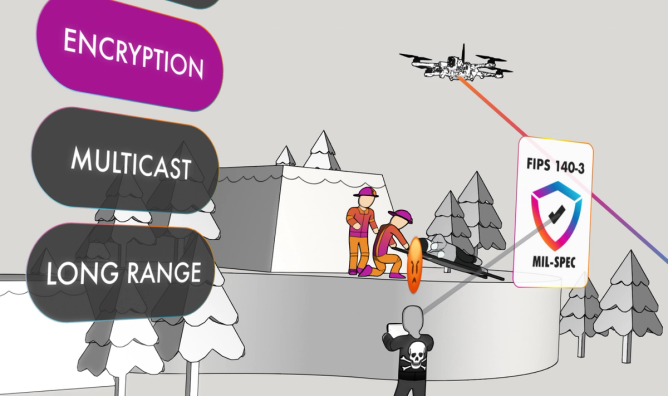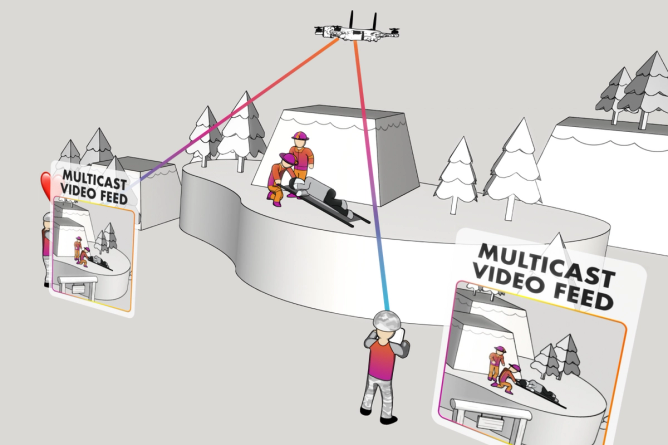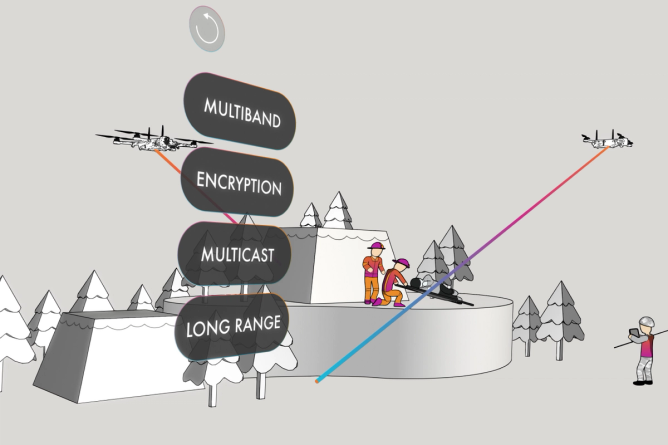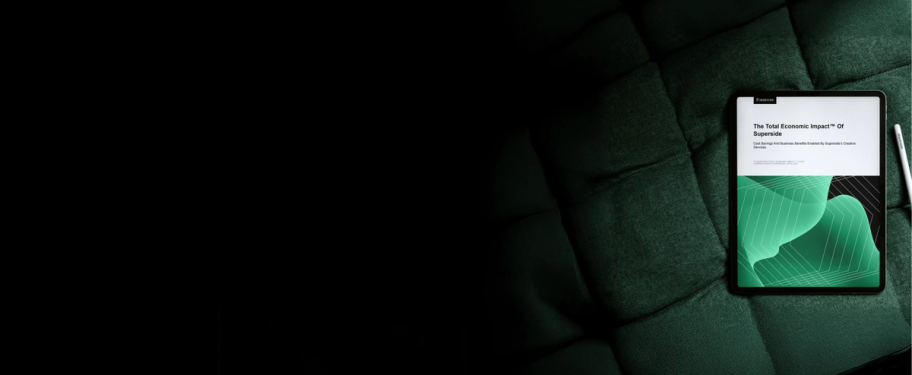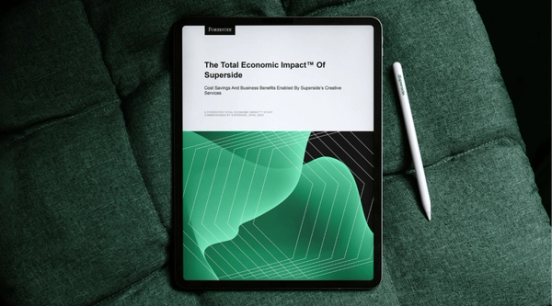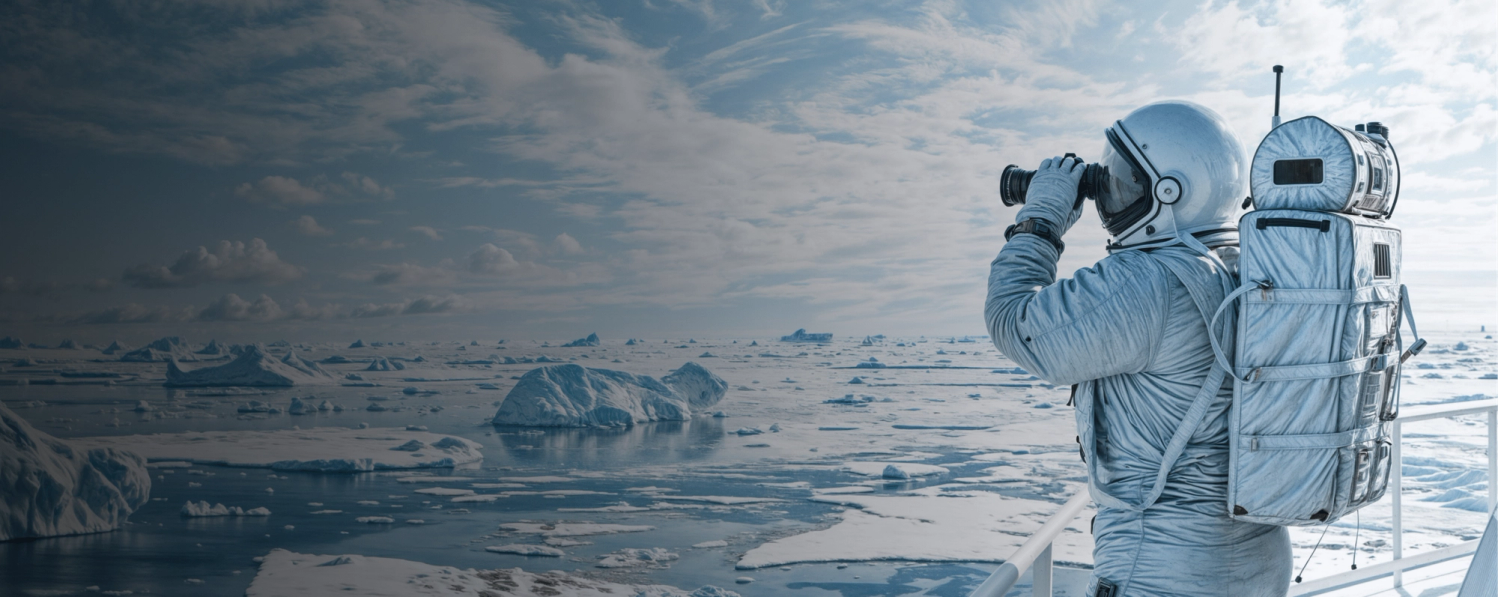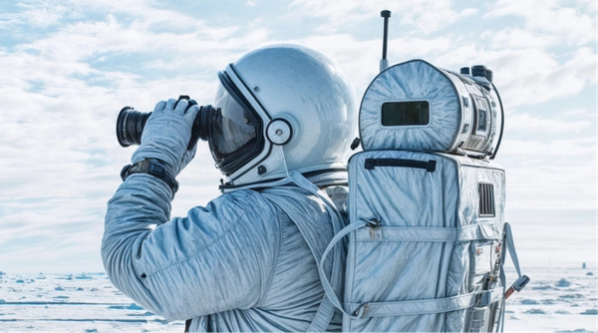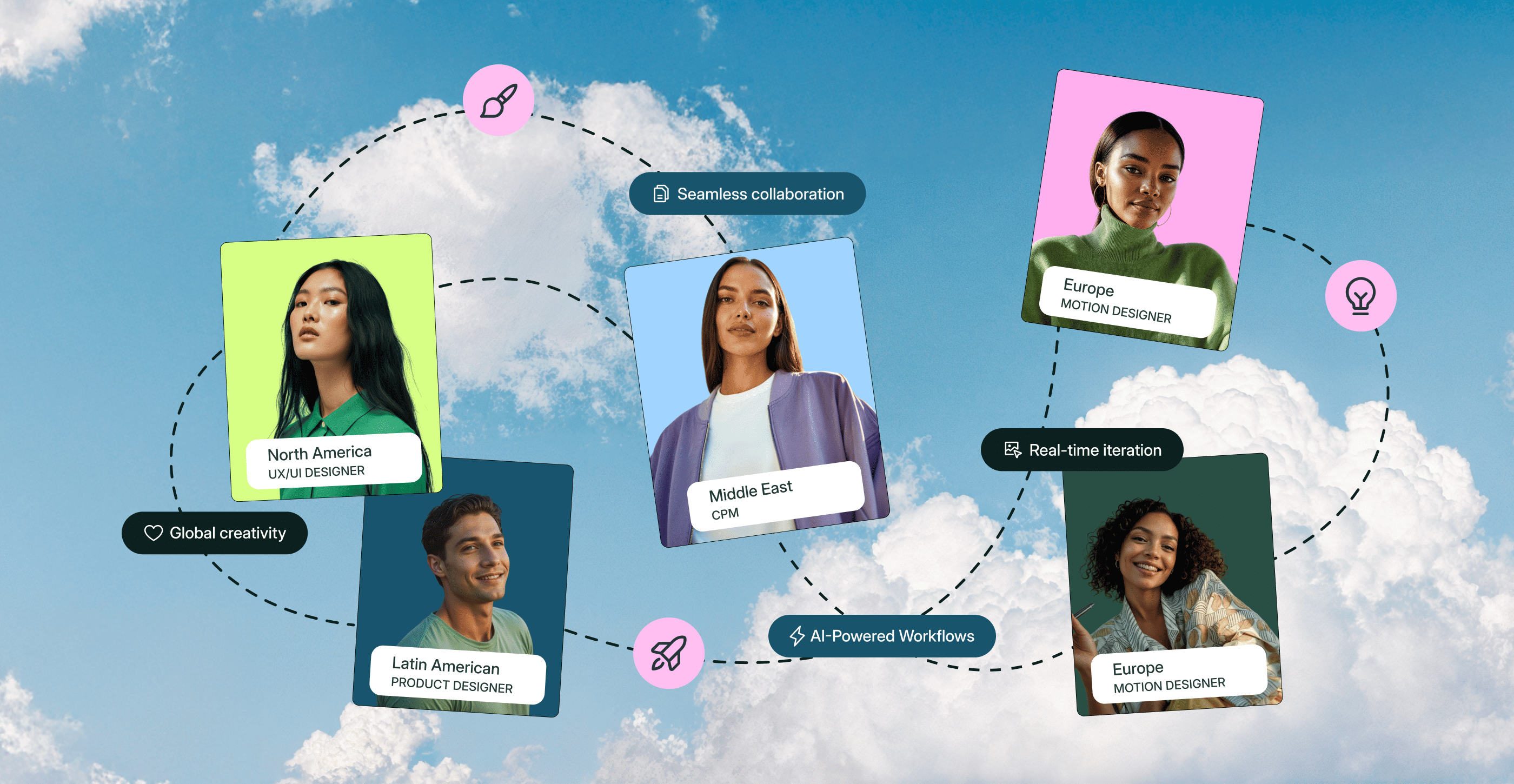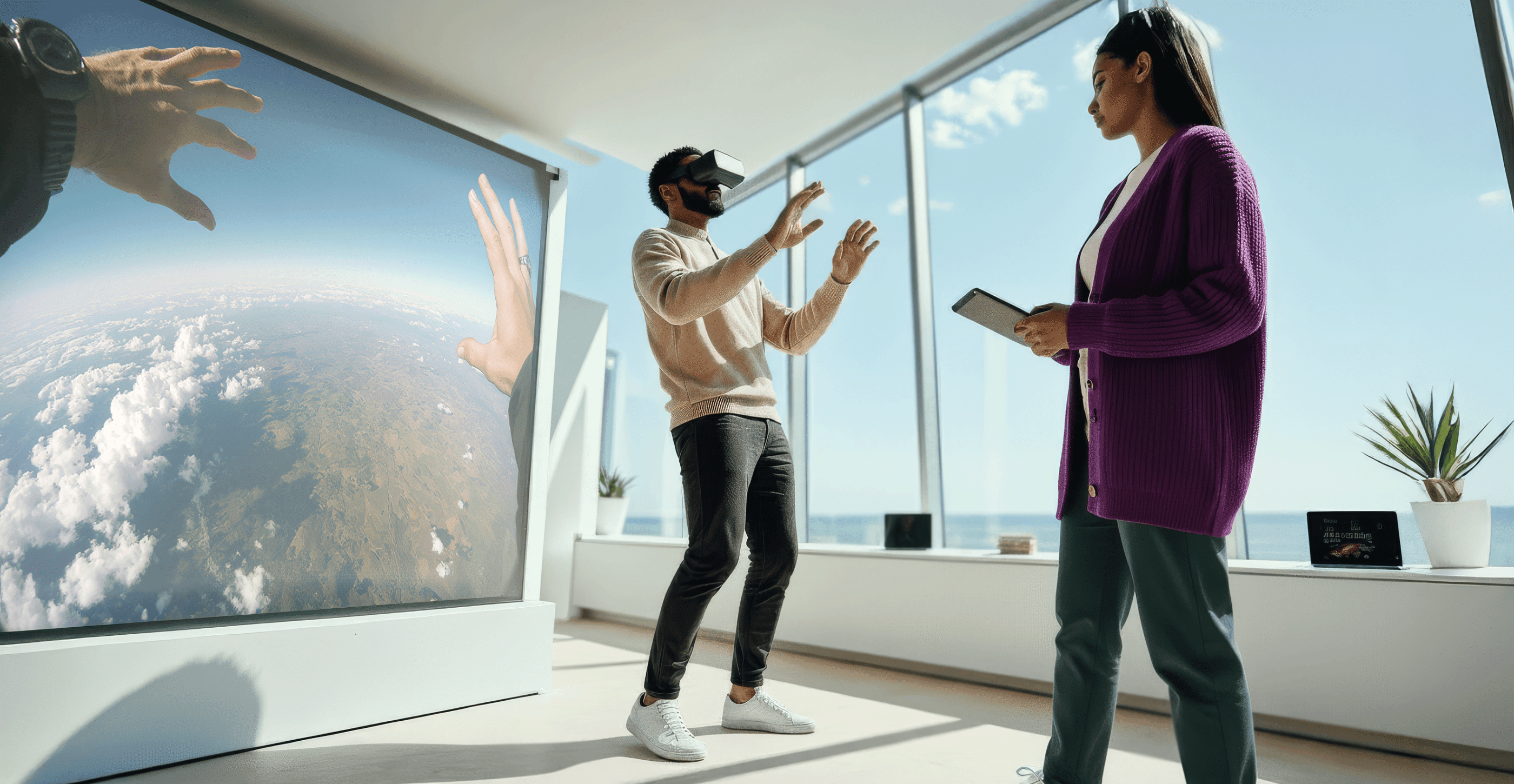
Get a fast peek into the immersive design services that shape today’s top brand stories. Discover how technologies like AR, VR, projection mapping and spatial AI deliver deep engagement, stronger customer loyalty and high ROI. Plus, learn how Superside brings all these capabilities and more together under one roof.
Picture this: You walk into a store, scan a QR code and watch a sneaker transform into a lifelike 3D model that shows how it looks and moves on your foot. It’s exactly what you want, and you tap to pay.
That’s immersive design in action.
Many top brands now lean into immersive experiences and Extended Reality (XR) for a reason. Audiences are bombarded with content, attention spans are short and fierce competition has made it tough to stand out.
XR covers the toolkit: Virtual reality (VR), augmented reality (AR) and mixed reality (MR). Immersive experience design incorporates these technologies (along with projection mapping, environmental installations, branded AR filters and more) to craft incredible sensory experiences.
Keen to use immersive design and XR but, like many others, don’t have the in-house bandwidth or skills? Let’s unpack the key technologies involved and the top studios that can help you bring incredible brand experiences to life.
Key technologies to create immersive experiences
Immersive storytelling, the essence of immersive design, makes people feel something. This design discipline blends digital and physical touchpoints in campaigns and interactive experiences to grab customers’ attention in a way static content can’t.
Consumers not only prefer immersive design, but it also delivers a high ROI for brands. Over 90% of U.S. shoppers already use or are keen to use AR to shop, and 98% of those who’ve tried it say it helped them make a purchase decision. Young consumers are particularly enthusiastic: 92% of Gen Z want to use AR tools when they shop online.
In retail, augmented and virtual reality implementations have led to a 20% lift in conversion rates and a 25% drop in product returns. In 2024, seven out of ten brands that invested in immersive marketing saw returns pay off.
Think of immersive design as the thread that weaves together sensory storytelling, spatial computing, motion and touch to create experiences people remember.
Now, let’s look at the various technologies involved.
1. Virtual reality (VR)
This immersive technology plunges you into a new world through head-mounted VR goggles or projection domes.
Why brands use it: VR lets enterprises create controlled, distraction-free environments where people can learn, explore or experience without limits. It’s ideal for realistic training, high-stakes simulations and virtual showrooms that remove geographic barriers.
2. Augmented reality (AR)
Augmented reality layers digital content onto the real world through a phone or tablet camera. Think filters, product overlays or interactive packaging that adds a virtual twist to physical experiences.
Why brands use it: Many retail brands use AR to bridge the gap between digital and physical shopping. The technology helps customers preview products in context. For example, they can see what a chair looks like in their home or test a lipstick shade virtually. AR filters paired with social media campaigns have become one of the most popular ways for brands to use augmented reality.
Check out a few AR marketing examples and AR brand experiences to get a better idea of what’s possible.
3. Mixed reality (MR)
Mixed reality goes a step further: It blends the digital and physical worlds in real time. With the help of advanced spatial computing and sensors, MR allows virtual objects to understand and respond to their environment. The objects can cast shadows, obey physics and appear truly part of the space.
Why brands use it: MR is ideal for hands-on product demos, design collaborations and training where realistic interaction matters. Enterprises use it to let teams manipulate 3D prototypes in a shared workspace, run immersive boardroom demos or create hybrid retail experiences.
4. 3D design and visualization
Studios use 3D design and visualization to create detailed, highly accurate models of products, spaces and characters that can be applied across AR, VR, web and physical activations.
Why brands use it: The best 3D product modeling agencies help enterprises create photoreal product renders for eCommerce applications, interactive 3D catalogs, character designs for campaigns and digital prototypes that speed up decision-making and asset creation. Many brands also extend 3D visualizations into physical experiences, from interactive retail displays to large-scale exhibition installations.
Read more about how brands unlock market opportunities with 3D and AR.
5. Projection mapping and installations
This experiential technology transforms buildings, stages and retail environments into dynamic, story-driven canvases. It precisely maps visuals onto physical surfaces and blends motion, light and architecture into one seamless experience.
Why brands use it: This transforms ordinary settings into unforgettable narratives, which leads to truly memorable brand storytelling. It’s used for large-scale events, stadium takeovers, product launches, retail activations and increasingly for art.
The biggest barrier to immersive marketing is bandwidth
The power of immersive marketing is undeniable, but it can be hard work to pull off these experiences. 60% of marketers say their biggest hurdle is simply not having enough team resources.
Superside’s Overcommitted report shows that 90% of in-house creative teams feel stretched too thin to pursue bold, innovative projects. That’s why immersive campaigns, often the first to get shelved, rarely leave the whiteboard.
Superside fills that gap and gives teams the bandwidth to push into immersive design without sacrificing everyday priorities (but more about this later).
What to expect from enterprise XR and immersive design services
When the time comes to choose an immersive design partner, it’s essential to look past flashy demos and pitches. Start by asking how the company can help you scale your creative output, manage complex immersive design projects and deliver real value.
Take our work with Reddit as an example of a concept that yielded impressive results. Reddit’s mascot, the Snoo, is a wide-eyed alien character that embodies the playful, community-driven spirit of the platform. Superside helped transform this beloved character into a complete 3D library of custom Snoos, each designed to reflect the unique personalities of Reddit employees.
Superside’s team gathered detailed character questionnaires from employees to capture their traits and quirks. These insights guided early sketch explorations before our team moved into full 3D production mode to deliver dozens of one-of-a-kind Snoos.
This project resulted in more amazing projects with Reddit's team, which included an installation at Reddit’s Magic Mirror event. Attendees could stand before a “magic mirror” and see themselves reflected as their personalized 3D Snoo.
The experience demonstrated how thoughtful immersive design can scale brand storytelling and connect people to companies in fun, unexpected ways.
Checklist: What a great immersive partner must provide
If you want to follow in Reddit’s footsteps and create standout immersive design experiences, look for the following in potential partners:
Tips for selecting the right immersive design agency
When you compare providers, how do you separate the ones who talk the talk from those who can deliver? That’s where a few practical tips make the decision easier.
- Look for enterprise experience: Experiential design companies that have scaled global campaigns for other brands have demonstrated their ability to handle both volume and complexity.
- Prioritize integration: Choose an immersive AR/VR design studio that will align its work with your brand and systems.
- Check collaboration tools: Agencies with clear workflows and platforms (like Superspace) can save you endless rounds of feedback.
- Ask for ROI proof: Request evidence of results (e.g., independent reports, case studies or verified cost savings).
Superside ticks all these boxes and more. We offer AR & 3D design, a full spectrum of world-class design services and an enterprise-ready subscription model to help you scale your creative output faster and further. Plus, independent research has confirmed that a partnership with us can result in a three-year ROI of 94%.
Top 8 immersive design services in 2025
Among hundreds of experiential design companies, only a select few deliver measurable ROI at enterprise scale. These are the partners trusted by global brands to turn AR filters into cultural moments, projection mapping into public spectacles and XR training into knockout results.
In this section, we share a list of the world’s top eight immersive design services. Each entry highlights what they offer, who their customers are, where they operate and why they’re worth your shortlist.
Jump straight to the leading immersive design partners in each category with the list below:
- Best immersive design service overall: Superside
- Best for projection mapping: Moment Factory
- Best in XR for experiential learning: Stereoscape
- Best for immersive installations: Canopy Creative
- Best for VR: Groove Jones
- Best for spatial AI: EON Reality
1. Superside
Services offered:
- Immersive design services for 3D & AR solutions
- 3D product modeling and visualization on multiple channels
- Interactive game design
- 3D illustration and ad creative production
- 3D scaled generation with AI custom models
- 3D character design
- Social media filters
- AR product showcase
- Front-facing and world-facing AR
Other design services offered:
- Social media and ad creative
- Branding
- Web design and email design
- Print, packaging and merch design
- Video production and motion design
- Illustration design
- Concept creation and digital marketing consulting
- Presentation design
- Design systems and product design services
- AI-enhanced creative and AI consulting services
Superside is much more than just an immersive design service. We’re a fully stacked creative partner that delivers anything you can imagine fast and affordably.
As the world’s leading AI-powered creative service, we help in-house teams scale their immersive experiences faster and more cost-effectively than most. We blend immersive design with every other creative need (e.g., ad campaigns, video, motion and cohesive brand systems), so you don’t have to juggle multiple vendors.
The proof, of course, is in the work.
For dynamic restaurant tech company Toast, we created hyper-realistic 3D product visuals and cut turnaround times for 3D assets by 85%.
Our global team of AR and 3D experts loves nothing more than taking projects from first idea to final execution with creative precision. And, as a Superside customer, you won’t just benefit from high-quality work. You’ll benefit from a frictionless creative process and a team that becomes a seamless extension of yours.
For Doodle Labs, a wireless telecommunications company, we not only built an explainer video. We also tapped into 3D motion design to transform complex radio-wave technology into a bold story for use at trade shows.
This is what you get with an immersive partner built to handle enterprise needs: Impressive, results-driven designs, delivered at the speed and scale the market now demands.
And for 6Sense, a B2B revenue technology platform, we delivered an Instagram AR filter and five custom animations in just three weeks. The project energized their flagship Breakthrough conference and drove sky-high engagement for the brand.
AI-enhanced prototyping helps us speed up delivery. Meanwhile, our robust design systems ensure that every creative output aligns with the brand, whether it’s for a product launch in San Francisco or an event activation in Singapore.
- Top customers: Shopify, Reddit, Amazon, Salesforce, Meta and more.
- Location: Worldwide.
- Cost: Custom. Book a call to learn more.
- Best for: Ambitious enterprise brands that need immersive design support for everything from branded AR pop-ups and XR narrative journeys to immersive campaign asset libraries and scalable templates.
2. Moment Factory
Services offered:
- Branded content
- Digital artwork
- Digital placemaking
- Immersive exhibits
- Interactivity and gamification
- Live performances and show direction
- Projection mapping
- Visual content creation and production
Moment Factory is an immersive experience studio known for large-scale immersive experiences. They typically blend video, lighting, sound, architecture, interactivity and special effects to transform public spaces into emotional journeys.
Whether the brief calls for a magnetic activation at a music concert or a vibrant museum installation, they use the latest technology and bold narratives to drive engagement.
- Top customers: Disney, Sony, Madonna, Billie Eilish, LAX and Microsoft.
- Location: Montreal, Canada; Paris, France; Tokyo, Japan; New York, United States; Singapore.
- Cost: Custom, enterprise-level, project-based.
- Best for: Enterprises, performers and cultural institutions that want to create immersive and emotive public experiences.
3. Rock Paper Reality
Services offered:
- AR experiences
- VR games and training
- MR activations
- 3D animation and VFX
- 3D installation services
- Generative AI experiences
- Strategy and immersive consulting
Rock Paper Reality is an immersive tech agency that builds AR, VR, XR and MR experiences at the intersection of storytelling, strategy and engineering. They blend creative vision with deep technical execution to develop standout experiences.
With well over a decade in the space and several patents in AR / immersive tech, they are trailblazers in this space.
They’ve also been recognized through awards (e.g., the Auggie Award for Best Location-Based Entertainment in 2025).
- Top customers: Adobe, Google, Red Bull and Toyota.
- Location: San Francisco, California, United States; Copenhagen, Denmark.
- Cost: Mid-tier to premium, project-based.
- Best for: Brands that want to craft stories through immersive campaigns that combine technical accuracy with clear, creative expression.
4. Dimension Studio
Services offered:
- Virtual production
- Visualisation
- Virtual worlds
- Digital humans
- Volumetric capture
- Performance capture
- Gen-AI
Dimension Studio has been at the forefront of virtual production for years. For instance, they contributed to Avatar: The Last Airbender via virtual production support and environment builds. They also supported the production of Wicked by digitally creating large crowd scenes.
Their most recent innovation is a new end-to-end AI content production pipeline for filmmakers and content creators.
- Top customers: Netflix, Apple TV and Sony Pictures.
- Location: London, United Kingdom; Rome, Italy; Washington, DC, United States.
- Cost: Premium, project-based.
- Best for: Ambitious film, TV and content creators who juggle tight schedules but want to create complex virtual environments.
5. Stereoscape
Services offered:
- Industrial and enterprise AR & XR
- Experiential and immersive learning
- Interactive marketing and brand communication
- Interactive exhibitions and installations
- Consulting and strategy for XR adoption
Stereoscape is a Finnish XR studio that builds immersive tools for workplace learning, productivity and customer engagement. They typically work with marketers, industrial audiences and training organizations.
The studio began with stereoscopic 3D conversions in 2009 but has since evolved into the production of cross-platform immersive experiences.
- Top customers: Wärtsilä, Nokia, Valmet, Neste.
- Location: Helsinki, Finland.
- Cost: Tailored enterprise solutions.
- Best for: Enterprises that need end-to-end support (strategy through deployment) in bringing XR into their operations or customer touchpoints.
6. Canopy Creative
Services offered:
- Immersive installations
- 3D art and animation
- 3D installation services
- VR, AR and MR experiences
- Gamification
- Projection mapping
- Enterprise XR services
- Hologram technology
- Digital twins
Canopy Creative, an Australian immersive experience design studio, bridges creativity and technology to create spatially intelligent experiences.
They specialize in the design of end-to-end immersive projects that include concepts, spatial design, content production, hardware integration, installation, calibration and ongoing operation.
Their work spans museum exhibits, theme-park installations, retail flagship showrooms, public art, training and simulation and location-based entertainment.
- Top customers: Qantas, Veritas Events, Wundr and Heritage Only.
- Location: Melbourne, Australia.
- Cost: Mid-tier to premium, project-based.
- Best for: Organizations that want to marry bold creative vision with immersive tech, especially those in sectors such as museums, cultural institutions, retail flagships, theme parks and training.
7. Groove Jones
Services offered:
- AI and machine learning–powered experiences
- XR (AR, VR and MR) development
- WebXR and WebGL applications
- Mobile, social and web AR
- Real-time 3D rendering and virtual production
- Volumetric capture, motion capture, CGI animation
Groove Jones is a creatively led tech company that has pushed the boundaries of immersive design since 2015.
Their team of artists and engineers builds experiences that inspire, entertain and scale, from VR360 experiences to XR games and AI-driven activations.
- Top customers: Lego, Toyota, Salesforce, Princess Cruises and ServiceNow.
- Location: Dallas, Texas, United States.
- Cost: Mid-tier to premium. About $50,000–$199,999 for AR/VR development.
- Best for: Fortune 500 and high-profile brands keen to deliver immersive activations that deliver spectacle and technological sophistication.
8. EON Reality
Services offered:
- AI-powered XR platforms
- Virtual and AR content creation tools
- Enterprise training and simulation
- Career and entrepreneur programs with AI mentors and XR simulations
EON Reality is a world leader in AI-assisted VR and AR-based knowledge transfer in education and industry training solutions.
At the heart of their business is their proprietary “Spatial AI” platform, which enables contextual awareness of 3D environments and powers immersive, interactive lessons, simulations and training scenarios.
In recent work, they’ve integrated AI agents and automated parts of the XR content generation pipeline.
- Top customers: Boeing, Microsoft, Lexus and Cornell University.
- Location: Irvine, California, United States.
- Cost: Enterprise and institutional licensing; custom pricing models (depends on scope).
- Best for: Fortune 1,000 companies, global enterprises and world-class academic facilities that seek scalable immersive learning and training solutions powered by XR and AI.
What’s the ROI of immersive design?
Immersive experiences deliver results, and not just in applause, but in metrics that matter to enterprise decision-makers.
Here’s why an investment in immersive design pays off:
1. Immersive environments boost brand recall
Consumers don’t just remember immersive experiences; they act on them. This is why it’s crucial to ensure your brand is represented accurately.
Recent research shows that experiential campaigns yield a 65% higher ROI, 70% stronger brand loyalty and twice the recall of traditional methods. In 2025, 62% of experiential marketing campaigns are credited with higher brand recognition than digital-only strategies.
2. Multi-sensory design deepens emotional impact
Experiences that engage all our senses (sound, sight, texture and scent) stay with us. Science also confirms that the brain’s emotional areas, like the amygdala, react more strongly when different senses work together to tell a story.
The stronger emotional reaction helps people remember immersive design experiences better and stay more engaged. The nutshell? Immersive design is more than marketing; it’s memory engineering.
3. Immersive design meets customer expectations
Brands are eager to rise above the noise, and today’s customers expect more than passive ads. As a result, 80% of companies have increased their experiential marketing budgets (about 10-30% of their overall marketing spend).
This means immersive designs are set to become the competitive baseline, not a novelty.
4. Superside proves the enterprise ROI
Immersive tactics like AR filters, 3D assets and XR activations can be slow and complex to implement. Heavy iteration and close coordination across design, development and production teams are usually required.
That’s where streamlined workflows (like those we follow at Superside) make a difference. They cut review cycles and keep delivery right on schedule.
The ROI of a Superside partnership isn’t hypothetical either. Our business impact has been independently verified in the Forrester Total Economic Impact (TEI) Report.
In just three years, we delivered over $4 million in business benefits, reduced agency costs by $1.9 million through ven dor consolidation, and saved our customers $1.2 million in internal labor. Read about it here:
For immersive campaigns, this efficiency means faster, cost-efficient delivery of 3D assets, AR activations and XR experiences.
And because the process is built for clarity and collaboration, with well-structured briefs, seamless teamwork and streamlined delivery, it feels less like outsourcing and more like working with an in-house creative partner.
Use Superside for immersive design services that drive enterprise growth
Immersive experience design isn’t for expensive, niche agencies anymore. B2B brands that want to stand out, build a loyal customer base and prove ROI need to try it out. No matter the tactic or technology, immersive experiences can change how target customers remember your brand.
Superside sits at the center of this shift. With AI-enhanced workflows, global creative firepower and a scalable studio model, we help enterprises build immersive experiences and virtual worlds that are always on brand, always on time and always built to perform.
And immersive design is only one part of the story. With Superside’s 20+ creative services, from 3D/AR to motion and video production, enterprises get a single, scalable partner for every creative need.
Unlike traditional agencies that bill by the project, Superside works on a subscription-based model. You benefit from predictable costs, unlimited requests and scalable creative support without the stress of scope creep or surprise invoices.
Time to bring your next immersive idea to life?
Then it’s time to Superside it.



